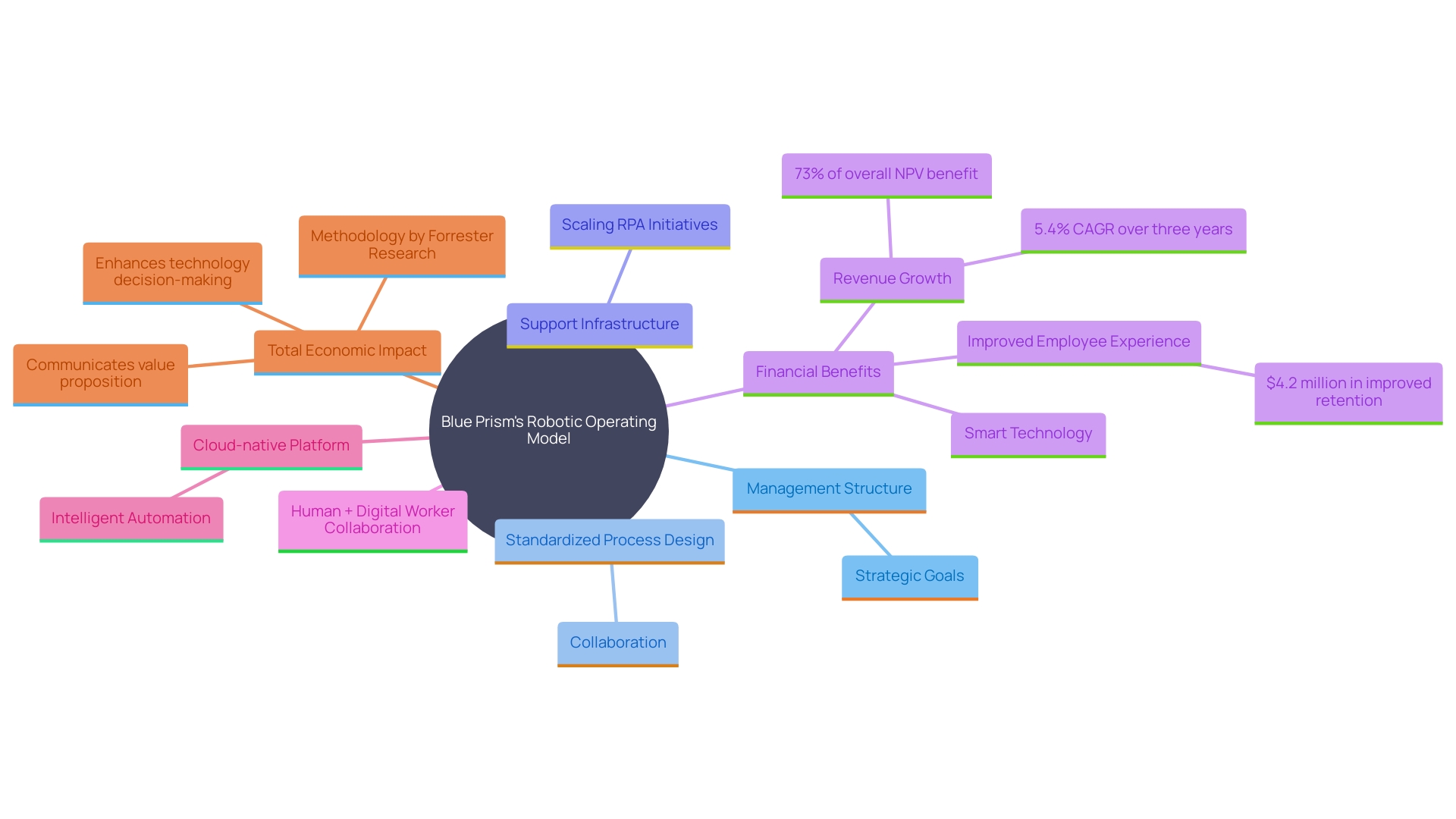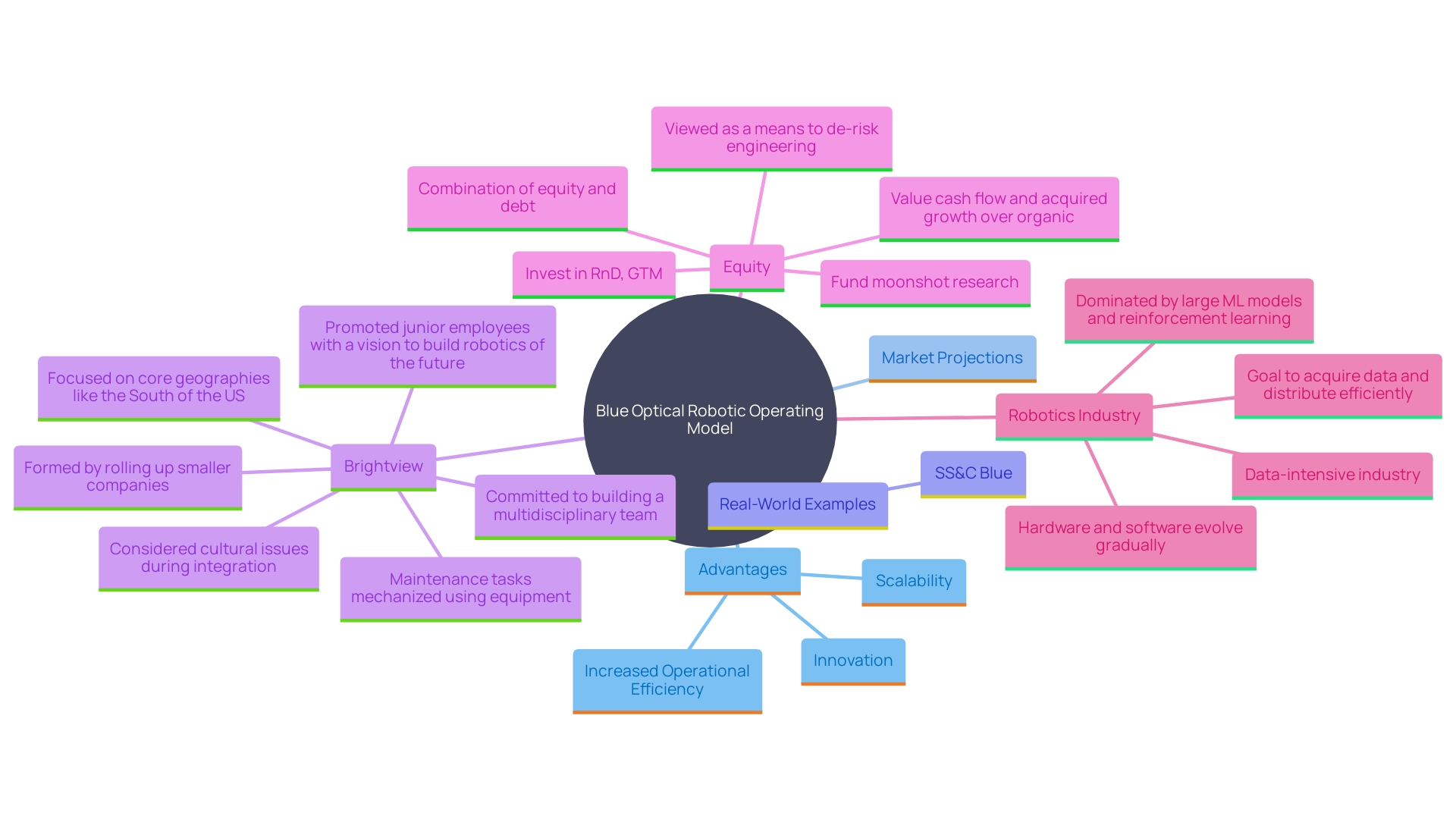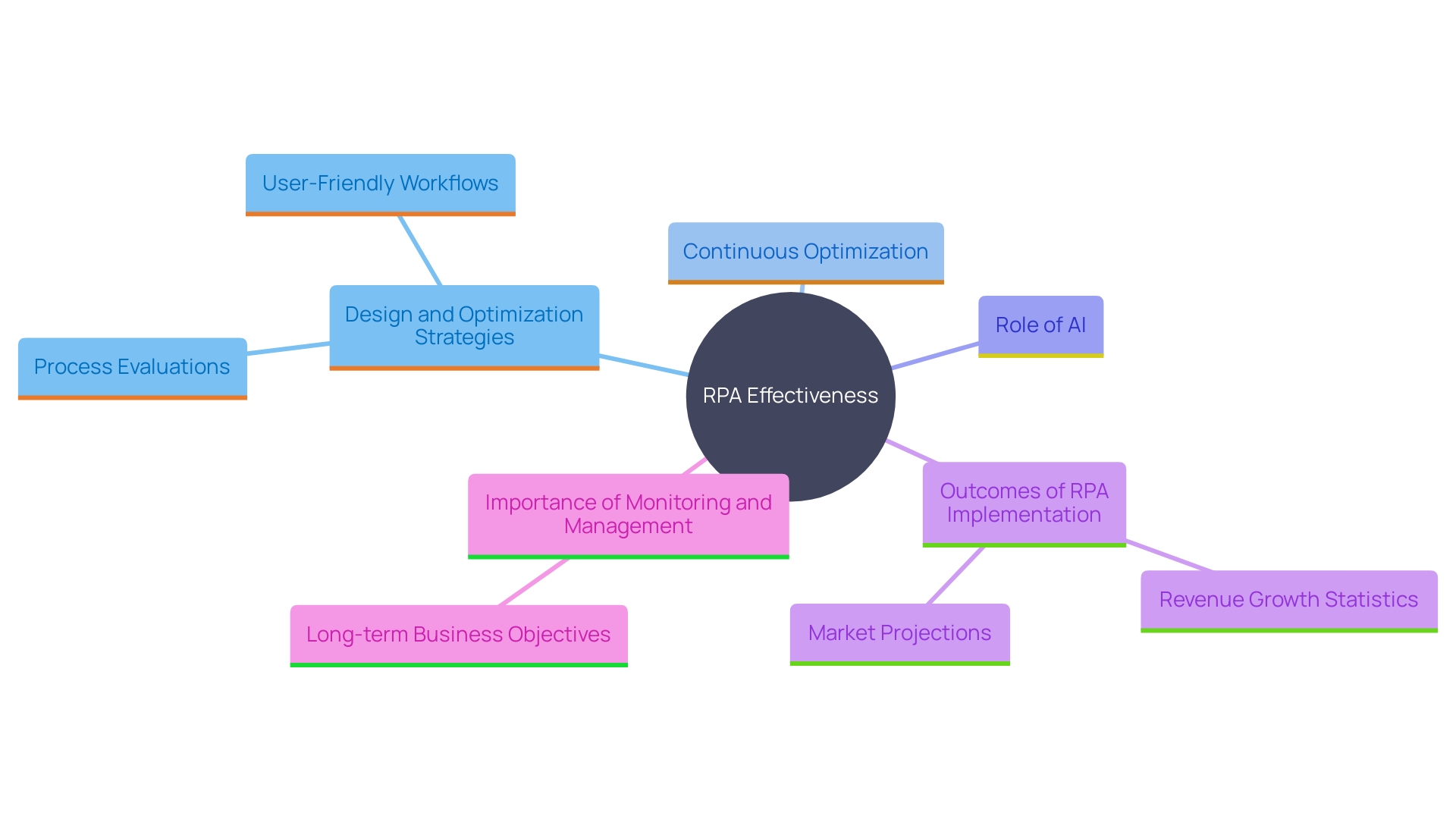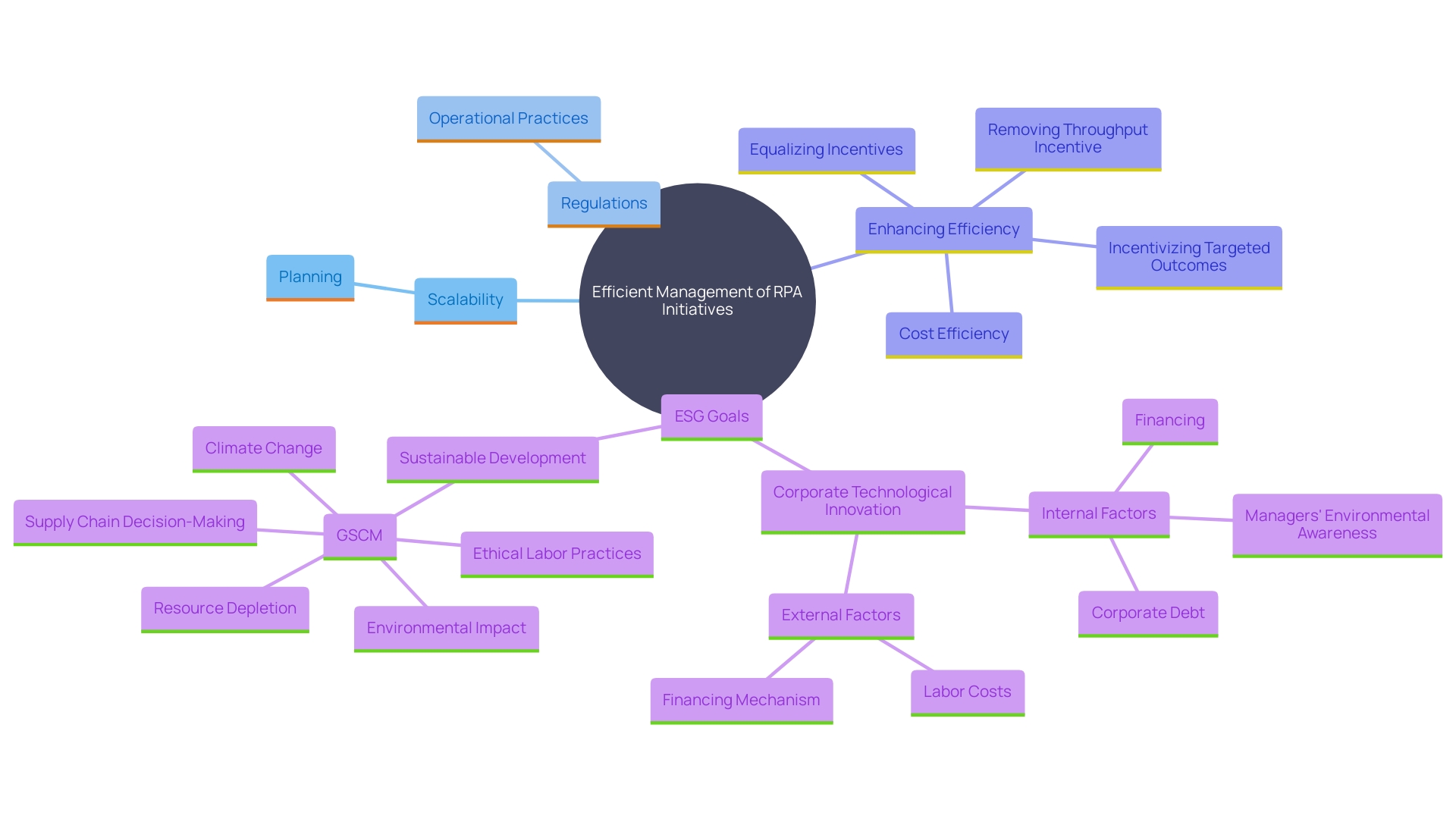Introduction
In the rapidly evolving landscape of automation, the Blue Prism Robotic Operating Model (ROM) emerges as a beacon for organizations striving for operational excellence. Integrating critical elements such as governance frameworks, standardized process designs, and robust support infrastructures, Blue Prism ROM offers a structured pathway to achieve seamless automation. These components are not just theoretical constructs; they are practical tools that align automation initiatives with strategic objectives, ensuring compliance and fostering collaboration across business, IT, and data governance teams.
As organizations navigate the complexities of scaling RPA initiatives, the insights and real-world applications of Blue Prism’s digital workforce demonstrate the profound impact of intelligent automation on productivity and employee experience. With a focus on continuous improvement and adaptability, the Blue Prism ROM sets the stage for organizations to unlock significant economic benefits and maintain a competitive edge in the market.
Key Components of Blue Prism ROM
Blue Prism’s Robotic Operating Model (ROM) integrates several foundational elements that are crucial for the successful implementation of automated processes. One essential element is the management structure, which guarantees adherence and aligns mechanization efforts with strategic goals. ‘This framework is supported by contributions from experts actively participating in technical management and decision-making processes, as noted by leaders in the industry.’.
Standardized process design is another core element, promoting consistency across various mechanization projects. This standardization is essential in fostering cross-functional collaboration among business, IT, and data governance teams. By establishing clear communication channels and regular meetings, stakeholders can share insights and work towards common goals, ensuring that projects involving automated processes are cohesive and efficient.
A robust support infrastructure is indispensable for managing and scaling RPA initiatives. This includes technical infrastructure capable of managing the complexities of automated technologies. For instance, SS&C Blue’s digital workforce enhances human abilities by handling repetitive and high-volume tasks, thus enabling employees to concentrate on more value-added activities. This approach not only enhances productivity but also leads to significant improvements in employee experience and retention.
Furthermore, the changing environment of smart technology requires a thorough support system that can adjust to new challenges and opportunities. With more than 2,800 clients globally, SS&C Blue demonstrates how smart technology can lead to substantial financial advantages, such as a 73% rise in total NPV benefit and a 5.4% compound annual growth rate over three years for composite clients. These statistics underscore the importance of a well-rounded support infrastructure in realizing the full potential of RPA.
In summary, Blue’s ROM offers a structured method for task execution through governance, standardized procedures, and a robust support framework. By leveraging these components, organizations can achieve greater consistency, compliance, and scalability in their automation efforts, ultimately leading to more efficient and productive operations.

Benefits of Implementing ROM in Automation
Embracing the Blue Optical Robotic Operating Model (ROM) offers unparalleled advantages to organizations. This model significantly boosts operational efficiency by automating repetitive tasks, allowing employees to focus on higher-value activities. The structured framework of Blue Prism ROM ensures rapid deployment and scalability, enabling businesses to adapt swiftly to evolving market conditions. By cultivating a culture of ongoing enhancement, ROM not only promotes innovation but also optimizes the return on investment in mechanization.
According to a report by Allied Market Research, the Robot Operating Systems market is projected to reach $1.8 billion by 2032, growing at a CAGR of 12.9%. This surge reflects the increasing acknowledgment of technology’s critical role in maintaining competitive edge. Real-world examples further illuminate these benefits. For example, SS&C Blue has changed many sectors by incorporating smart processes, which has resulted in a $4.2 million enhancement in employee experience and retention throughout its clientele.
Furthermore, the thorough strategy of Blue Prism ROM corresponds with the wider trend of utilizing intelligent processes to address technical challenges and promote organizational change. By orchestrating comprehensive processes with machine learning applications, businesses can achieve new levels of efficiency and agility. As Chhavi Arora from McKinsey emphasizes, adopting such frameworks is crucial for capturing the complete value of mechanization and preparing the workforce for upcoming challenges.

Design and Optimization Strategies
To maximize the effectiveness of RPA, organizations should focus on design and optimization strategies aligned with the Blue Prism ROM. This involves conducting thorough process evaluations to identify opportunities for mechanization, followed by designing user-friendly workflows. Continuous optimization is essential; leveraging analytics to monitor bot performance can lead to iterative improvements, ensuring that RPA solutions remain efficient and aligned with business objectives. As per a study conducted by Forrester Research, firms that invested in smart systems experienced a 73% increase in revenue and a 5.4% compound annual growth rate (CAGR) over three years. Monitoring, management, and upgrades continue to be a part of the process, including Artificial Intelligence (AI). Like all technological advancements throughout history, AI has aimed to improve efficiency, productivity, and convenience, but it still requires a human partnership to ensure stability. For example, a welding and steel fabrication company reduced touch-up work by 50% through an automated solution, saving significant time. Additionally, the Robot Operating Systems Market is projected to reach $1.8 billion by 2032, growing at a 12.9% CAGR. This growth emphasizes the rising dependence on technology to remain competitive. By starting with smaller tasks and continuously monitoring results, organizations can ensure that their RPA initiatives yield tangible benefits and align with long-term goals.

Governance and Scalability Considerations
Efficient management is essential for overseeing RPA initiatives within the Blue Prism ROM framework. Establishing clear policies and performance metrics ensures accountability and transparency, particularly when scaling operations. As noted in the finance department of Mass General Brigham hospital, a streamlined approach to automation enabled them to overcome significant bottlenecks, demonstrating the importance of oversight in achieving operational efficiency.
Scalability should be a primary consideration in RPA planning. As organizations anticipate growth, they must ensure their infrastructure can support an increasing number of bots without compromising performance or security. This approach is echoed by the recent advancements from ConnectWise, which integrated RPA into its foundational technology, enabling companies to handle more tasks efficiently and cost-effectively.
Furthermore, the necessity for strong management frameworks is highlighted by the EU’s comprehensive AI regulations. These regulations set clear obligations for high-risk AI systems, emphasizing the importance of transparency and risk mitigation. This corresponds with findings from a study involving the 300 largest companies, which highlighted the positive impact of RPA on environmental, social, and management (ESG) factors. By focusing on effective governance, organizations can not only enhance their efficiency but also contribute to broader ESG goals.

Conclusion
The Blue Prism Robotic Operating Model (ROM) stands as a transformative framework for organizations seeking to harness the full potential of automation. By integrating essential components such as governance frameworks, standardized process designs, and robust support infrastructures, Blue Prism ROM provides a structured pathway that aligns automation initiatives with strategic goals. This alignment fosters compliance and encourages collaboration among business, IT, and data governance teams, laying the groundwork for successful automation initiatives.
Implementing the Blue Prism ROM yields significant benefits, including enhanced operational efficiency and improved employee experiences. The model’s structured approach allows for rapid deployment and scalability, enabling organizations to swiftly adapt to changing market conditions. Real-world examples underscore the economic advantages of adopting intelligent automation, highlighting how businesses can achieve substantial returns on their automation investments while fostering a culture of continuous improvement.
To maximize the effectiveness of RPA, organizations must prioritize design and optimization strategies that align with the Blue Prism ROM. Conducting thorough process assessments and continuously monitoring bot performance through analytics ensures that RPA solutions remain efficient and aligned with business objectives. Effective governance and scalability considerations are vital for managing RPA initiatives, ensuring accountability, transparency, and the capacity to scale operations without compromising performance.
In conclusion, embracing the Blue Prism Robotic Operating Model equips organizations with the tools necessary to navigate the complexities of automation. By leveraging its comprehensive framework, businesses can unlock significant economic benefits, enhance operational efficiency, and prepare for future challenges in the ever-evolving landscape of intelligent automation.

